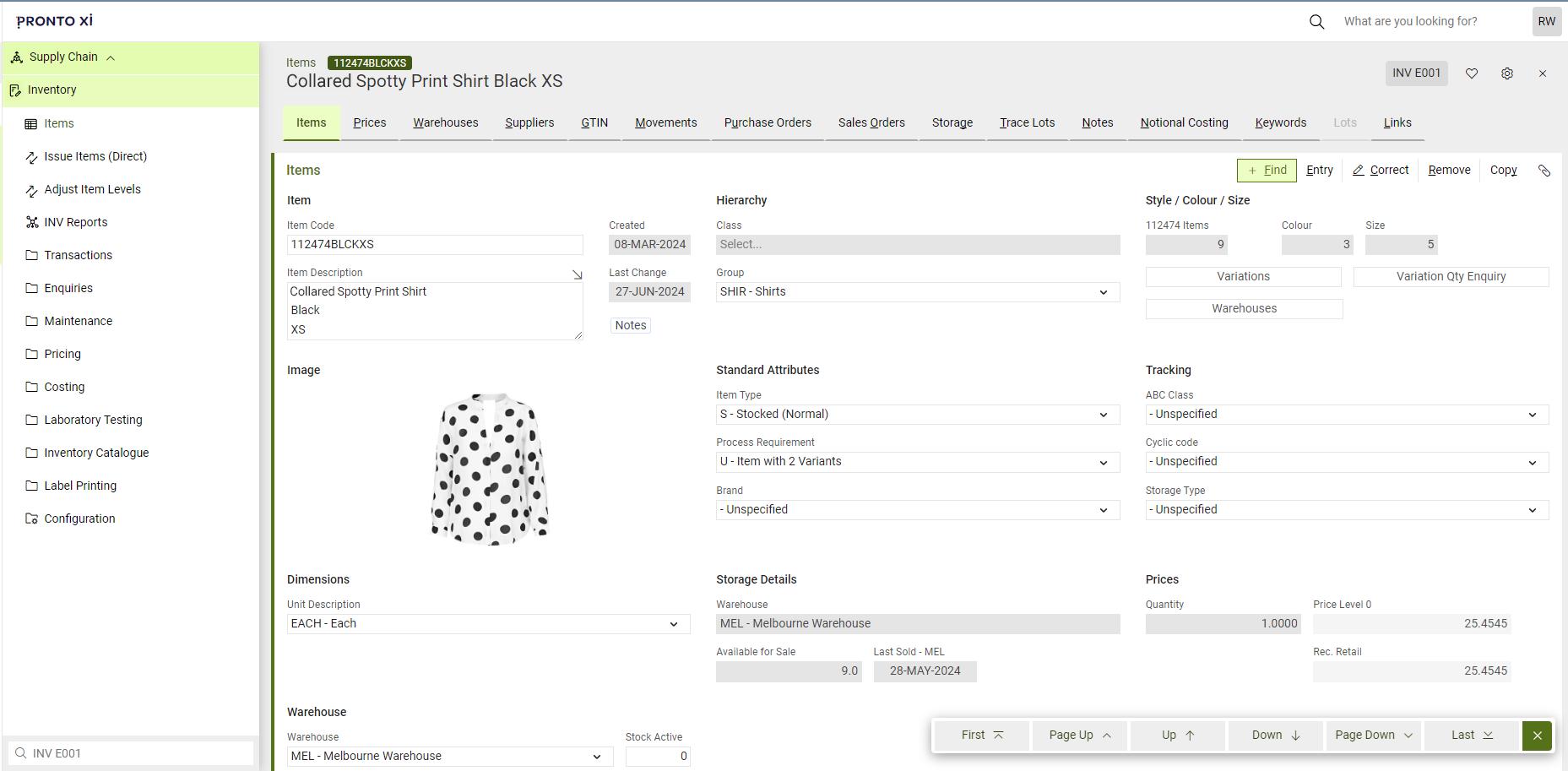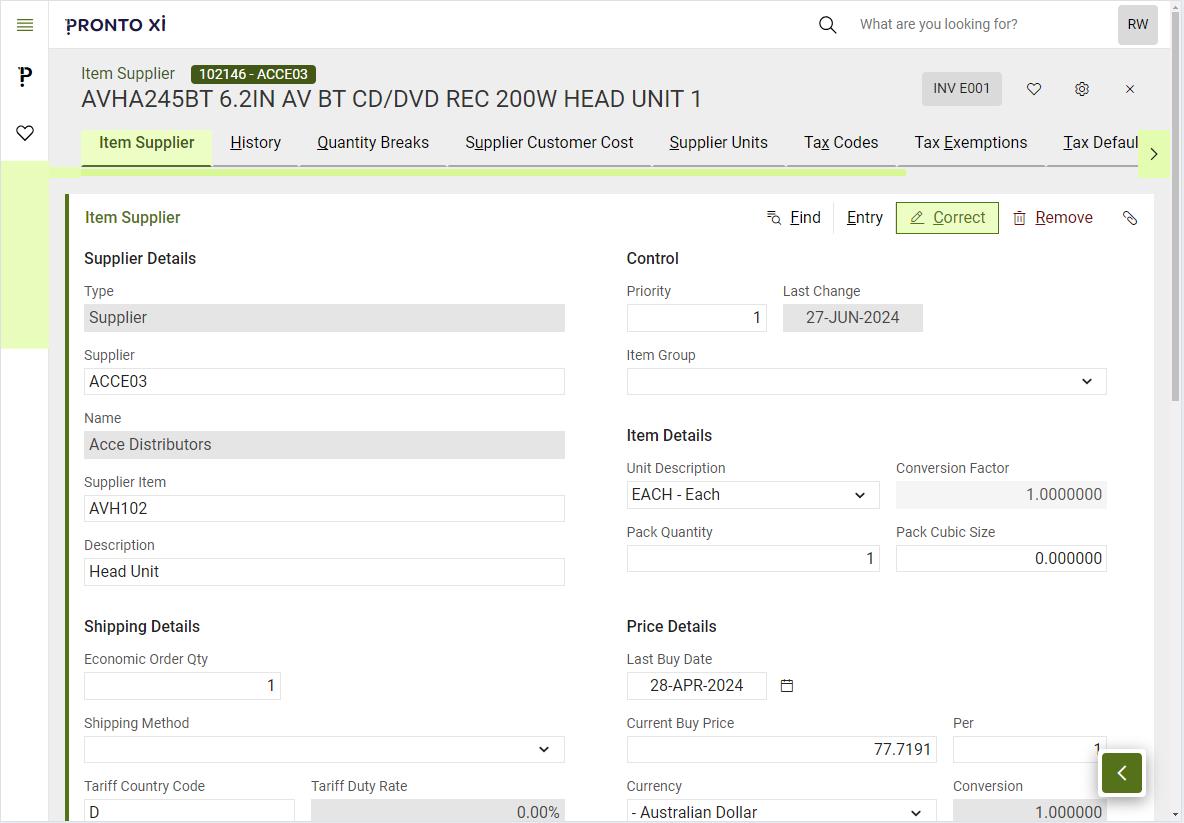Applications Overview



Pronto Software, Pronto, Pronto Xi, the Pronto interrobang logo, the P interrobang logo, Pronto Woven, Pronto iQ and Pronto Cloud are all registered trademarks of Pronto Software Limited. All other marks are the property of their respective owners. Copyright © 2024 Pronto Software Limited (ABN 47001337248).
This document contains statements related to our current and future developments that may constitute forward-looking statements. They are subject to changes and may be available in a Pronto Xi 780 service pack or future release of Pronto Xi. All diagrams, drawings, product screenshots and any other types of visualisations in this document, use demo or synthetic data created for display purposes only.

Maintain detailed information about an inventory item
With seamless integration with Pronto Xi modules such as Purchasing and Manufacturing, and the ability to track stock by warehouse, Inventory gives you complete visibility over your business’s inventory.
Key features include:
•multiple warehouses, suppliers and prices per item
• variant items: style, colour and size
• serial number and lot tracking
• multiple units of measure (UOM) and first-in, first-out (FIFO)
• support for Global Trade Item Number (GTIN) barcodes
• standard, average, FIFO, actual and replacement costings
• item licences
• stocktake and cycle counting
• interactive image display for products
• item attributes
• automated reordering and replenishment
Inventory records the information and transaction history associated with an item. To create or maintain an item, use the main Items Maintenance screen.
We’ve introduced Item templates so you can maintain and manage industry-specific inventory information for industries such as chemical, paper, retail, wholesale distribution, timber and mining.
It handles the following types of items:
• Stocked or standard — A normal saleable item which is typically purchased but can also be manufactured
• Manufactured — Items with components, a bill of materials (BOM) and routings
• Raw materials — Items that are not saleable and do not have a BOM, but can be transferred using a transfer sales order
• Indent — Items that are not generally held in stock but are purchased subject to a sale
• Kit — A combination of various types of items
• Labour — Items that have a cost and a selling price but there is no necessity to control the quantity on hand (for example, items used as components to cost labour in a BOM or in kits)
• Specials — Items with a cost and a selling price, but because they are generally used to control cost overhead recovery or are consumables (for example, expense items such as stationery or electricity), there is no necessity to control the quantity on hand
Inventory master records can also include additional information or notes, such as hazardous or dangerous goods documentation.

Record the information of each inventory items with Inventory master records
Inventory provides you with the flexibility to manage multiple processes for a single inventory item.
For example, you may have an item that needs to be configured as backflushed, in line with your manufacturing process, but also requires license controls. With Inventory’s process requirement functionality, you can configure the required options in one easy step.
The module’s main Inventory Maintenance screen displays selected and relevant information based on your item type. If Inventory Maintenance includes a screen you don’t need, create an item template to hide fields. The mode button at the top also provides access to additional screens for warehouses, suppliers, pricing, alternatives, notes, BOM and more.
Inventory tracking is available in the Warehouse Management System (WMS), but Inventory also allows you to maintain pick and bulk locations against each warehouse in the non-WMS environment.
The inventory warehouse information records and tracks movements, costs and commitments for each item in each warehouse, helping you to manage your reordering requirements.
In addition, the Warehouses screen permits you to:
• determine inventory postings to the General Ledger
• record sales history
• automatically receive items from other warehouses via internal transfer orders
It accommodates various types of warehouses, including standard and advanced warehouses, factories, service vans (inventory stored in fleet vehicles) and consignments.
The screen also captures detailed inventorylevel information for each warehouse, including stock on hand, supplier orders and order commitments.
Inventory movements in each warehouse are recorded, summarised and displayed by transaction type.

Hide fields that are not required within inventory maintenance
The Supplier screen allows you to set up a supplier for an item by region, record pertinent information and track performance levels. Specify any number of suppliers.
Supplier attributes include:
• supplier preference
• supplier item code, description and conversion factor
• minimum order quantity
• supplier item group
• pack quantity and volume for cost apportionment of freight charges
• supplier estimated and most recent lead time
• multiple quantity price breaks by supplier
• foreign currency pricing iPad Air view on Inventory Supplier record


Manage flexible pricing, promotions, and competitor tracking with ease
Inventory allows you to set pricing structures within the inventory master records. Maintain multiple pricing levels for each item, apply promotional prices for specified periods or set-up price algorithms and discount matrices. Tax rules are handled either at the item level or globally.
An item’s basic pricing record consists of a base price, multiple prices for different categories or quantity breaks, and the recommended retail price. Each item may have additional pricing structures defined by customer group or Warehouse.
Recalculate item prices based on a mark-up value or by applying a percentage increase over current prices. Your current price list can also be copied into a price maintenance environment — where price changes can be manipulated — before you update the current price lists.
Inventory also allows you to keep track of competitor prices.
Inventory includes the following master fields for each item, giving you complete flexibility and control over how you handle the detail.
The item code is an alphanumeric field used to identify items in Pronto Xi.
Each item includes a three-line product description. In addition, an extended notes facility allows you to store unlimited text for internal and external purposes.
The product hierarchy is a multi-level classification system that clearly defines your business’s product classification.
The five-level structure has many benefits, including enhanced inventory management and reporting capability via Pronto Xi modules such as Business Intelligence.
You can select how many of the five “levels” of the hierarchy are turned on, and Inventory’s flexible maintenance means the hierarchy can be maintained from the top down or bottom up, making it suitable for various business needs and industries.
Associated functions such as price maintenance, reordering and bulk item maintenance can leverage active hierarchy levels. Data integrity is maintained by enforcing the hierarchical relationships between each “child” and “parent”.
Posting inventory transactions to the General Ledger is fully automated.
Categorise items by product groups, which is beneficial for:
• recording sales history
• posting to the General Ledger for sales, cost of goods sold and more
• reporting
• dissection of prices, discounts and promotions
• calculation of sales representative commissions
• inventory valuation
Establish prices, discounts and promotions based on product groups, for example, contract price by customer type/item group and promotional discount by customer type/ item group. You can also establish special commission rates for sales representatives by product group.
Item attributes help extend the description of a product through a structured and ordered categorisation. Importantly, use attributes as data points to “slice and dice” sales data and uncover customer buying habits and preferences. These insights can then be used to create sales promotions, forecast purchases and exchange data with Avenue and eCommerce platforms.
An alternative part number (APN) for a specific item can be used to include the code of another item, which is cross-referenced when the first item is superseded.
The universally recognised Global Trade Item Number (GTIN) is the industry-accepted barcode for a specific item. A single item can have multiple GTINs to reflect various units of measure, such as consumer unit, traded unit or pallet.
Use APN and GTIN for enquiry, reporting and scanning directly into Inventory.
Apply multiple units of measure for the sale, warehouse storage and procurement of each inventory item. You can also store pack weights and cubic dimensions.
Inventory allows you to trace items using various methods, including:
• Serial-tracked — Used when the goods are received, at dispatch, or both
• Lot-tracked — Used for batch tracking, this facilitates full traceability from purchase to product recall, if required
• Purchase-tracked — Used for tracking by purchase order number
Import tariffs/excise tax
When an item is imported from a foreign supplier, the tariff charged depends on the supplier’s country and the nature of the item.
Inventory uses a country code to identify the country of origin and a tariff code to identify the class of the item for tariff purposes. The country code is stored against the supplier, while the tariff code is held at the item level.
Inventory holds comprehensive transaction details for each item and warehouse, including control numbers (for example, serial or lot number), source documents and financial information.
You can also define the retention period for historical data files.
Most inventory issues are captured within other Pronto Xi modules, such as Shopfloor Manufacturing or Sales. However, in some instances, you may need to record inventory issues manually.
Record issues against the following:
• Manufacturing (Factory/WIP or work order)
• Project (General Ledger or Service Call)
• General Ledger
• Maintenance
• Inventory Adjustment
• receipts from purchase order or work order
The manual recording of issues typically occurs within the Purchasing module. However, Inventory includes a fast and simple option — called Manufactured Goods Receipt — to receive goods purchased without using the BOM to create and process a formal work order.
A Manufactured Goods Receipt is a simple method of recording the receipt of manufactured items in an inventory. As goods allocated to a work order are sometimes returned unused, use this option to return the components back into inventory.
Hold goods for release until they have passed through quality checks. If goods do not pass the checks, Inventory allows you to reject, scrap or return the items to the supplier.
Inventory includes reordering functions, allowing you to automatically create purchase orders and work orders according to selected criteria and review these before creating the actual orders.
Reorder Reports calculates the reorder quantities needed to satisfy your business’s commitments, minimum and maximum inventory levels, or a combination of these factors. You can also use average sales history, average warehouse demand or forecast to plan requirements.
The reorder processing calculation considers a number of factors, including:
• minimum and maximum days cover
• minimum and maximum inventory levels
• economic order quantity
• lead time
• current inventory level, including current commitments
• items on order from supplier
• in transit
• internal requisitions
Inventory holds budget information at the item, planning group or item group level.
You can manually enter budgets for each period of the year. You can also use spread factors which include weightings or ratios to fix each period’s relative proportion of the annual amount.
Pronto Xi also offers numerous reports comparing budgets against actual sales and cost listings.
Maintain various costs — such as standard, average, FIFO and actual — in Inventory for posting purposes, valuations and sales margin reporting.
Produce inventory valuation reports at any time using the costing method of your choice and, if necessary, recalculate costs based on a range of factors.
Landed costs are calculated as part of the shipment costing process in Accounts Payable.

Kits are a list of components made up of saleable items that can be optionally selected during the sales order process. For example, a computer, keyboard, monitor and mouse can be sold individually or as a kit.
Inventory accommodates various categories of kit component lines, including:
• mandatory
• optional
• variable quantity
• grouped options
Generate kit pricing from the components or simply select from the item price record.
To help you measure your inventory accurately, Inventory generates a snapshot view of holdings. Any adjustments are automatically reflected in the General Ledger.
To ensure company policies are adhered to, Inventory supports wall-to-wall and cycle counting techniques, as well as data-capturing techniques such as tickets, barcodes, radio frequency (RF) and cards.
The stocktake process includes:
• Initial pre-stocktake check — Inventory reports on any outstanding inventory-related transactions that need completing prior to the book inventory’s final snapshot
• Prepare stocktake — Inventory creates a snapshot file of your inventory holding and, if required, produces a Stocktake Report. A unique stocktake control code is generated as part of this process to facilitate easy identification and parameters
• Stocktake refreeze — Pronto Xi have the ability to refreeze the same stocktake file in the instance of an emergency order despatch
• Enter counts — Inventory employs multiple data-entry techniques, including manual data entry
• Produce reports — Inventory generates reports to assist with reconciliation, including uncounted items, variations and valuation reports
• Update stocktake — Inventory performs an update once the stocktake is finalised, and makes any necessary adjustments to the stock ledger and General Ledger for the appropriate accounting period
We are an Australian developer of award winning business management and analytics solutions. Pronto Xi, our Enterprise Resource Planning (ERP) software, integrates accounting, operational and mobile features in a single system – optimising business processes and unlocking actionable insights. That’s why for more than 45 years, over 1,500 Australian and global organisations, across a wide range of industries, have trusted Pronto Xi to simplify their most complex challenges. With headquarters and our Development Centre located in Melbourne, we have support offices and consultants based across Australia, as well as a global network of Resellers and Solution Partners. Specialised business units within Pronto Software have the expertise to assist you with pivotal technology – Digital Transformation with Pronto Woven, Cloud and Hosting services with Pronto Cloud and Business Intelligence solutions with Pronto iQ.
When you choose Pronto Software, you gain a team with deep industry experience, giving us the ability to understand your specific needs and build innovative solutions that drive business growth and revenue.